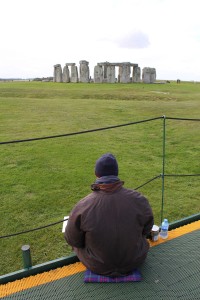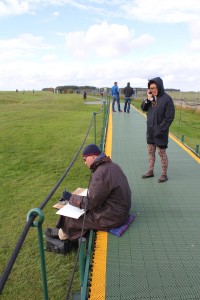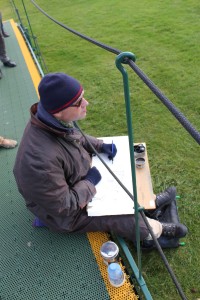Stonehenge – Wednesday 3rd October
Passing Airman’s Cross you can be in no doubt there is a major development happening in the middle of this patch of English countryside. The site for the new Stonehenge visitor centre is now partially fenced off. Huge boards line up along the road marking the outer boundary. Glossy panels announce the coming environmental improvements. There are portacabins and skips, diggers and portaloos, vehicles of all shapes and sizes and a workforce mainly dressed in Day-Glo yellow.
Autumn is here. The trees are showing signs of a shift from green and the temperature is dropping. A posse of soldiers is visiting Stonehenge; young men in desert camouflage fatigues and maroon berets speaking an Arabic language.
And some more, wearing variants of green camouflage and black berets with a red band around them. They’ve taken a few photos but it seems very business like, more recce than tourist treat. Like most people here, they’re clearly on a schedule.
A tour guide, female in her 20s with a beige mackintosh over her black suit, printed list in hand, walks anti-clockwise in black heels to chivvy some stragglers along.
Another couple of soldiers come by, firmly glued to their audio guides, dark green camouflage and black berets. One is carrying a large rucksack. It isn’t only the tourist operation in this part of Wiltshire that is International – apparently the MoD’s is too.
Mark is sitting on the low metal bridge in front of the Heel Stone. He’s doing an ink study at 240°. He’s almost drawn a complete circuit of the stones in first draft. He’s beginning to learn it.
It can look so different depending on the light. Details are hidden for hours then suddenly show themselves as the sun’s rays shift round. It’s a very complex group of stones. Maybe that’s why not many artists have tackled it in this amount of detail. It’s possible to get a quick impression of it as a drawing or painting, but actually honouring the details of the stone circle as it is now is quite a task.
Today, as most days last week, there are a great number of German students here – mid to late teens. Some great goofing for photos, mainly large group shots, but they’re happy being out in the open, chatting with and entertaining each other. How much Stonehenge resonates with them is hard to tell.
I found a wonderful description by Lord Chesterfield writing in 1756 about young Englishmen travelling abroad for the Grand Tour and in particular the stop off in Paris:
“The life of Les Milords Anglais is regularly, or if you will, irregularly this. As soon as they rise, which is very late, they breakfast together, to the utter loss of two good morning hours. Then they go by coachfuls to the Palais, the Invalides, and Notre Dame: from thence to the English coffee-house, where they make up their tavern party for dinner. From dinner where they drink quick they adjourn in clusters to the play where they crowd up stage, drest up in very fine clothes very ill made by a Scotch or Irish tailor. From the play to the tavern again where they get very drunk and where they either quarrel among themselves or sally forth, commit some riot in the streets, and are taken up by the watch. Those who do not speak French before they go are sure to learn none here. Their tender vows are addressed to their Irish laundress, unless by chance some itinerant English-woman eloped from her husband, or her creditors, defrauds her of them. Thus they return home, more petulant, but not more informed than when they left it: and show, as they think, their improvement, by affectedly both speaking and dressing in broken French.”
(Delaforce. P. – The Grand Tour – Robertson McCartna Ltd. 1990)
Give or take a few details, educational group travel to foreign destinations for the young has possibly not changed very much.


